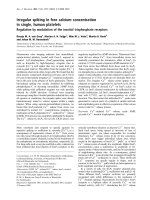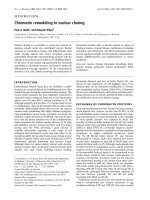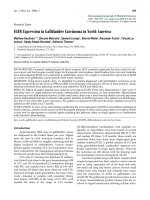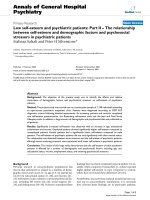Báo cáo y học: "Opioid-induced constipation in intensive care patients: relief in sigh" doc
Bạn đang xem bản rút gọn của tài liệu. Xem và tải ngay bản đầy đủ của tài liệu tại đây (40.16 KB, 2 trang )
Page 1 of 2
(page number not for citation purposes)
Available online />Abstract
Constipation is the most common gastrointestinal complication
associated with opioid therapy in chronic pain patients, and also
frequently occurs in sedated intensive care unit patients. Conven-
tional therapy may not provide sufficient relief from constipation,
which can be severe enough to limit opioid use or the dose. In a
recent study on terminally ill patients suffering from laxative-
resistant opioid-induced constipation, Thomas and colleagues
demonstrated subcutaneous methylnaltrexone to rapidly induce
defecation. This appealing result might also have favourable
prospects for intensive care patients, as their outcome is often
codetermined by recovery of bowel functioning.
Gastrointestinal complications are very common in patients
on intensive care units [1]. The highest occurrence of delayed
gastric emptying is observed in patients with head injuries,
burns, multisystem trauma, and sepsis [2]. The aetiology of
bowel dysfunctions, in some cases progressing to a paralytic
ileus, is certainly complex, and major contributing factors on
the intensive care unit include parenteral nutrition, mechanical
ventilation, hypoperfusion, shock, dehydration, secretion of
inflammatory mediators as well as endogenous and exoge-
nous opioids [3].
Opioids are commonly used on the intensive care unit to treat
pain or for sedation; their efficacy is accompanied by
burdensome side effects, however, the most frequent being
nausea, respiratory depression, impaired cognition, urinary
retention, and bowel dysfunction [4]. Opioid-induced bowel
dysfunction encompasses delayed gastric emptying
accompanied by increased gastroesophageal reflux, as well
as constipation [4]. Constipation is not only discomforting but
can also cause abdominal distension, vomiting, restlessness,
gut obstruction and perforation, and may be associated with
aspiration or fatal pulmonary embolism [5]. A large survey in
250 intensive care units has shown that constipation occurs
in up to 83% of nonsurgical critical care patients, delaying
weaning from mechanical ventilation (28%), delaying enteral
feeding (48%) and delaying hospital discharge (18%) [5].
Opioid-induced bowel dysfunction remains a clinically
important problem that is the source of much suffering, and
new treatment approaches are anticipated. Thomas and
colleagues should therefore be commended for their
important contribution to tackle this problem [6]. In their
multicentre trial of 133 terminally ill patients suffering from
laxative-resistant opioid-induced constipation, they demon-
strated subcutaneous methylnaltrexone to rapidly induce
defecation within several minutes to hours. Furthermore, this
μ-opioid receptor antagonist had no influence on the overall
incidence of adverse events, and neither did it affect central
analgesia.
Oral application of methylnaltrexone is more convenient than
injections and, as it acts directly in the bowel, is believed to
be safer and more efficient [7]; this approach therefore
seems to be an appealing alternative to laxatives. Moreover,
repeated administration of intravenous methylnaltrexone has
been shown to be well tolerated, with no significant adverse
events or changes in opioid subjective ratings and with no
clinically noteworthy alterations in pharmacokinetics [8].
Only about 4% of intensive care units currently have
guidelines for treating constipation [5]. Various laxative
interventions exist at present; however, despite constipation
often being overcome, the time of laxation can be un-
predictable [9].
Several types of pharmacologic agents are used to treat
opioid-induced constipation, including osmotic or lubricant
laxatives, stimulant laxatives (orally and rectally), and pro-
kinetics. The effects of such therapies are nonspecific and are
generally unpredictable, often generating diarrhoea or cramps
[9]. Furthermore, most of these drugs cause severe side
effects – such as acetylcholine, which induces bradycardia
and increases respiratory secretions; cisapride, a 5HT
4
agonist that is no longer clinically available because of
cardiac complications; or metoclopramide, which is believed
to have little colonic effect [4].
Commentary
Opioid-induced constipation in intensive care patients:
relief in sight?
Daniel Chappell, Markus Rehm and Peter Conzen
Clinic of Anaesthesiology, Ludwig-Maximilians University, Nussbaumstrasse 20, 80336 Munich, Germany
Corresponding author: Daniel Chappell,
Published: 1 July 2008 Critical Care 2008, 12:161 (doi:10.1186/cc6930)
This article is online at />© 2008 BioMed Central Ltd
Page 2 of 2
(page number not for citation purposes)
Critical Care Vol 12 No 4 Chappell et al.
Stimulant laxatives, such as senna and bisacodyl, can induce
painful abdominal cramping upon activation, whereas sugar-
based osmotics produce gas that can lead to uncomfortable
bloating [4]. Systemic opioid antagonists such as naloxone
have been shown to reverse bowel dysfunction, but there
was often a clinically unacceptable percentage of unpredic-
table systemic opioid withdrawal and increased pain [10].
Moreover, many patients do not respond to such therapies.
New, more specific, pathophysiologically based treatments
are therefore needed. Peripheral selective opioid antagonists
such as methylnaltrexone or alvimopan, which do not cross
the blood–brain barrier, promise to decrease bowel
dysfunctions without any effect on central analgesia. Their
antagonism of μ-opioid receptors in the gastrointestinal tract
seems to reverse opioid-induced gut hypomotility [9].
Whereas alvimopan has been shown to counter opioid-
induced delays in the gastrointestinal transit time, a previous
study has been suspended due to an apparent increase in
cardiovascular events [11]. The promising therapeutic
approach of Thomas and colleagues presented in the New
England Journal of Medicine to avoid opioid-induced consti-
pation showed no increase of adverse events compared with
a placebo group [6]. Moreover, there were no differences in
mean pain scores at baseline and at each evaluation of
patients between the study group and the placebo group.
As patient outcome is often codetermined by recovery of
bowel functioning, these μ-opioid receptor antagonists
should also be very effective in intensive care treatment.
Delayed defecation on the intensive care unit prolongs the
hospital stay and the length of mechanical ventilation whilst
increasing the need for vasopressors and opioids, increasing
organ failure and increasing mortality [12].
Accelerating gastrointestinal recovery during intensive care
could increase patient comfort, decrease the average
hospital stay, and reduce costs and readmission rates. This
hypothesis should initiate future trials investigating pharma-
cological anticonstipation strategies with μ-opioid receptor
antagonists in our intensive care unit patients.
Competing interests
The authors declare that they have no competing interests.
References
1. Mutlu GM, Mutlu EA, Factor P: GI complications in patients
receiving mechanical ventilation. Chest 2001, 119:1222-1241.
2. Nguyen NQ, Ng MP, Chapman M, Fraser RJ, Holloway RH: The
impact of admission diagnosis on gastric emptying in criti-
cally ill patients. Crit Care 2007, 11:R16.
3. Reintam A, Parm P, Redlich U, Tooding LM, Starkopf J, Köhler F,
Spies C, Kern H: Gastrointestinal failure in intensive care: a
retrospective clinical study in three different intensive care
units in Germany and Estonia. BMC Gastroenterol 2006, 6:19.
4. Thomas J: Opioid-induced bowel dysfunction. J Pain Symptom
Manage 2008, 35:103-113.
5. Mostafa SM, Bhandari S, Ritchie G, Gratton N, Wenstone R:
Constipation and its implications in the critically ill patient. Br
J Anaesth 2003, 91:815-819.
6. Thomas J, Karver S, Cooney GA, Chamberlain BH, Watt CK,
Slatkin NE, Stambler N, Kremer AB, Israel RJ: Methylnaltrexone
for opioid-induced constipation in advanced illness. N Engl J
Med 2008, 358:2332-2343.
7. Yuan CS, Foss JF: Oral methylnaltrexone for opioid-induced
constipation. JAMA 2000, 284:1383-1384.
8. Yuan CS, Doshan H, Charney MR, O’Connor M, Karrison T,
Maleckar SA, Israel RJ, Moss J: Tolerability, gut effects, and
pharmacokinetics of methylnaltrexone following repeated
intravenous administration in humans. J Clin Pharmacol 2005,
45:538-546.
9. Berde C, Nurko S: Opioid side effects – mechanism-based
therapy. N Engl J Med 2008, 358:2400-2402.
10. Liu M, Wittbrodt E: Low-dose oral naloxone reverses opioid-
induced constipation and analgesia. J Pain Symptom Manage
2002, 23:48-53.
11. Liu SS, Hodgson PS, Carpenter RL, Fricke JR Jr: ADL 8-2698, a
trans-3,4-dimethyl-4-(3-hydroxyphenyl) piperidine, prevents
gastrointestinal effects of intravenous morphine without
affecting analgesia. Clin Pharmacol Ther 2001, 69:66-71.
12. van der Spoel JI, Schultz MJ, van der Voort PH, de Jonge E: Influ-
ence of severity of illness, medication and selective deconta-
mination on defecation. Intensive Care Med 2006, 32:875-880.









